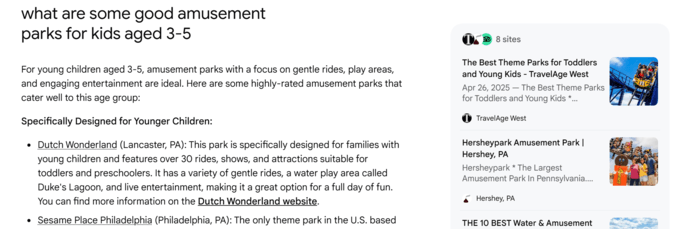Back in 2024, Google CEO Sundar Pichai set the stage for AI Mode, remarking that the company needed to “move faster” in 2025 and “be relentlessly focused on unlocking the benefits of this technology [AI].”
So far, Google’s delivered.
After less than three months in Google Labs, the company’s launched AI Mode, a Gemini-powered AI search experience that now asks SEOs to move faster and adapt to the new search landscape.
Discover what that means for SEOs (and search engine optimization) now!
Jump ahead to what you want to know:
- What is Google AI Mode?
- What’s the difference between AI Mode and AI Overviews?
- How does Google’s AI Mode work?
- How does AI Mode impact SEO?
- How should SEOs respond to AI Mode?
- How can you appear in AI Mode responses?
What is Google AI Mode?

Google AI Mode is an end-to-end AI search experience, similar to ChatGPT. While AI Mode still mentions brands and cites sources (similar to AI Overviews), it doesn’t include the 10 blue links of traditional search results.
What is the difference between AI Mode and AI Overviews?
There are a few differences (and similarities) between AI Mode and AI Overviews:
| Area | AI Mode | AI Overviews |
| Citations | X | X |
| Organic search results | — | X |
| Ads | X | X |
| Analytics | — | — |
The most concerning for SEOs is the lack of organic search results, since SEOs have already seen the impact of AI Overviews on traffic (on average, they lower click-through rates (CTRs) by 34.5%), and the inability to track these touchpoints. Learn more about the future of AI Overviews.
How does Google’s AI Mode work?
Understanding how search and answer engines work is an essential skill for SEOs.
When it comes to Google’s AI Mode, on the surface it functions similar to AI Overviews — it uses a custom version of the company’s Gemini model to generate responses. Where it differs is in how that model works.
Instead of relying solely on the user’s query, AI Mode uses a fan-out technique that issues multiple queries at once. You can see this in action when searching. In the example below, for example, AI Mode issues 16 different searches.

AI Mode also comes with additional search capabilities, like:
| Capability | Purpose | Example |
| Deep Search | For in-depth reports with citations | Do deep research on the costs, timeframe, and considerations of a home renovation project for a two-story house with 1 bedroom and 2 baths |
| Live | For real-time searches using video and audio | Help me find what screw I need to fix this table |
| Agentic | For task-based searches | Can you help me find and buy tickets for Lorde’s upcoming tour? |
| Shopping | For ecommerce-based searches | Help me find dress options for a semi-formal evening wedding in the summer |
| Personal context | For enhancing searches based on past searches or connected apps, like Gmail | Help me find some places to eat based on my upcoming trip to Oregon |
When it comes to how AI Mode cites or ranks websites, there are a few acknowledged signals from AI Overviews that likely play a role in which websites appear in AI Mode’s generative answers:
- Core ranking systems, like Helpful content
- Databases, like Google Shopping Graph
- Structured data, like Product or LocalBusiness
Which leads to the next question for SEOs — how does AI Mode affect you?
How does AI Mode impact SEO?
Google’s AI Mode impacts SEO in a few ways, including:
Visibility
Like ChatGPT, Gemini, and other answer engines, AI Mode doesn’t have 10 blue links. You either get cited — or you don’t. For SEOs (and the businesses they represent) that means less visibility throughout the buyer journey, which can impact downstream metrics like sales.
Traffic
SEOs have already seen a correlation between increased AI Overviews and decreased website traffic, with some sites losing 20 – 60% of their traffic. With AI Mode, you’ll likely continue to see reduced traffic from Google.
Analytics
The lack of analytics isn’t a new conversation between SEOs and Google. While Google Search Console tracks AI Overviews and AI Mode touchpoints, SEOs cannot filter the data to see where impressions or clicks come from — traditional search, AI Overviews, or AI Mode.
Strategy
SEO is foundational to appearing in Google’s AI Mode (and other AI-powered search experiences), but practitioners need to build on that foundation in order to dominate these AI search experiences — and that starts with rethinking strategy when it comes to:
- Content originality
- Content readability
- Content organization
It’s important to keep in mind, though, that AI Mode’s impact on search engine optimization depends on its adoption. Unlike AI Overviews, which appear in the traditional search experience, AI Mode requires users to change their behavior — they’ll have to select a different tab to start searching.

How should SEOs respond to AI Mode? (3 next best steps)
The next best steps SEOs can take when it comes to AI Mode are:
1. Reset expectations
If you haven’t already, reset leadership’s expectations when it comes to traffic. You will most likely see (if you haven’t already) traffic declines due to AI Overviews and AI Mode since Google is the largest search engine in the world.

“Our AI results may give people more context about a topic overall, and display more relevant supporting links, than with classic Search.
This may provide a more engaged audience and new opportunities with visitors, but you might not optimize for these if you focus too much on clicks instead of the overall value of your visits from Search.
Consider looking at various indicators of conversion on your site, be it sales, signups, a more engaged audience, or information lookups about your business.”
However — depending on your SEO strategy — you should see increases in qualified traffic. Publicly-traded companies like NerdWallet and HubSpot have seen this, reporting decreased traffic numbers but increased revenue.
NerdWallet, for example, generated 35% more revenue in 2024, but lost 20% of its monthly website traffic. This example, which is seen across industries, hints at the shift search engine optimization needs to take.
2. Expand from SEO to OmniSEO®
That shift is from search engine optimization to search everywhere optimization — or OmniSEO®. AI Mode is just one example in a growing list (ChatGPT, Meta AI, and Claude) of how search has changed.

People are using more than Google to find what they need, and SEOs need to adapt to that if they want to help businesses get discovered online — and turn that visibility into quote requests, in-store visits, or purchases.
The best place for learning how to get started with OmniSEO® is in our Search Everywhere Optimization Guide, but you can find a few highlights of how this approach works in the meantime below:
| Strategy | Tactics |
| Produce elite content |
|
| Maximize brand reputation |
|
| Solidify SEO |
|
Explore Search Everywhere Optimization Guide
3. Lean into SEO fundamentals
Finally, the most important step that SEOs can take is to lean in to search engine optimization fundamentals. Continue producing optimized content, optimizing local listings like Google Business Profile, and generating reputable backlinks.
“Be fearful when others are greedy, and be greedy when others are fearful.” – Warren Buffet
Websites with a strong SEO foundation are more likely to appear in AI Overviews, and it’s likely some of those factors play into AI Mode in order for the AI search experience to deliver accurate and helpful responses.
Google reiterates the need for search engine optimization in its own documentation, which advises webmasters looking to succeed in AI search experiences like AI Overviews and AI to:
- Ensure Google’s crawlers can access your site
- Provide a great page experience through improved speed, usability, and design
- Create unique, reliable, and people-first content
- Verify structured data matches the displayed content
- Support content with visuals, like high-quality images and videos
- Maintain an up-to-date Google Business Profile and Merchant Center (if applicable)
That’s why it’s critical to continue leaning into SEO vs. pulling back in fear.
How can I appear in AI Mode responses?
When it comes to appearing (or ranking) in AI Mode responses, we know a few things:
- AI Mode is “rooted” in Google’s core quality and ranking systems
- AI Mode uses real-time information from the web, Knowledge Graph, and Shopping Graph
- AI Mode uses its training to determine when and how to link to information
The Google Search Central team has expanded on these details (see the previous section) by highlighting the need for foundational search engine optimization elements, like crawling and indexing, helpful content, and page experience.
What isn’t mentioned, though, that SEOs should do? A few things, including:
- Build your off-site presence, like through linked and unlinked mentions, to build your brand’s reputation as a trusted source and recommended product or service; the more specific the mention, the better.
- Optimize your local targeting, like through on-site content or local listings, to target location-specific (and less competitive) AI Mode queries. Note that AI Mode will most likely link to your Google Business Profile in these instances.
- Strengthen your omnichannel marketing, like email and social media, to improve your relevancy signals when AI Mode references a person’s Gmail and other connected apps to personalize responses.
Besides these optimizations to appear in AI Mode, consider what happens when you do earn a visit to your site. You’ll want a marketing strategy for nurturing these more qualified users into not just first-time customers but long-term brand champions.
If you’re curious about your website’s presence in AI Overviews now, check out our free AI Overview Checker tool.
Move faster (and scale your online visibility) now
You can move faster and adapt to today’s search landscape. And you don’t have to wait to learn OmniSEO® to do it. At WebFX (the team behind SEO.com), we’ve helped our clients appear across search experiences, from AI Overviews to Perplexity to ChatGPT, and we’re ready to help your business do the same with our OmniSEO® solution.
Discover what’s possible by contacting us today for a custom proposal!

Grow Your Visibility Beyond Google
Capture leads and traffic from emerging search platforms like ChatGPT, Perplexity, and Google AI.

TLDR;
-
How is Google AI Mode impacting SEO?
Google AI Mode answers a user’s search directly — eliminating the need to click-through to a website, which impacts SEO significantly by decreasing website traffic, brand awareness, and revenue in some cases.
-
What are the key changes and impacts on SEO?
AI Mode’s key changes and impacts on SEO include the following:
- Limiting brand visibility by displaying 1-3 sources in its response (Users must click “Show all” to view the remainder)
- Reducing clicks or traffic by answering a user’s search from within the AI experience
- Changing relevant metrics by prioritizing search visibility over clicks and traffic
- Emphasizing content originality by citing specific, easy-to-read, and data-backed content
-
How should SEO strategies adapt to Google AI Mode?
SEO strategies can adapt to Google’s AI Mode by:
- Rethinking which metrics measure SEO success, like visibility vs. traffic
- Producing thoughtful and original content that cites data points, offers specific advice or instructions, and makes understanding the topic easy
- Optimizing content with structured data to help crawlers understand it


Grow Your Visibility Beyond Google
Capture leads and traffic from emerging search platforms like ChatGPT, Perplexity, and Google AI.
Writers

Related Resources
- Do I Need AI SEO? Yes. Here Are 3 Compelling Reasons Why
- Do I Need GEO? Yes, if You Want to Stay Agile in 2025 and Beyond
- GEO vs. SEO: Key Differences and Importance in Digital Marketing
- Google Ads + AI Overviews: Everything You Need to Know
- Google Gemini & AI SEO: How to Rank in Gemini’s Answers
- How Do I Get My Products to Be Recommended in ChatGPT? A Guide to Instant Checkout
- How to Appear in ChatGPT Answers: a Guide for Businesses
- How to Do ChatGPT SEO (And How to Use It for SEO)
- How to Increase Visibility in Local Searches with AI SEO for Local Businesses
- OmniSEO® – Rank Everywhere

